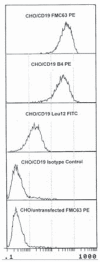Multiple Myeloma Includes Phenotypically Defined Subsets of Clonotypic CD20+ B Cells that Persist During Treatment with Rituximab
- PMID: 21892289
- PMCID: PMC3161648
- DOI: 10.4137/cmo.s615
Multiple Myeloma Includes Phenotypically Defined Subsets of Clonotypic CD20+ B Cells that Persist During Treatment with Rituximab
Abstract
Potential progenitor B cell compartments in multiple myeloma (MM) are clinically important. MM B cells and some circulating MM plasma cells express CD20, predicting their clearance by treatment with anti-CD20. Here we describe two types of clonotypic CD20+ B cell in peripheral blood of myeloma patients, identified by their expression of CD19 and CD20 epitopes, their expression of CD45RA and their light scatter properties. Thus, the circulating component of the MM clone includes at least two distinct CD19+ CD20+ B cell compartments, as well as CD138+ CD20+ plasma cells. To determine whether either or both B cell subsets and the CD20+ plasma cell subset were depleted by anti-CD20 therapy, they were evaluated before, during and after treatment of patients with rituximab (anti-CD20), followed by quantifying B cell subsets over a 5 month period during and after treatment. Overall, all three types of circulating B lineage cells persist despite treatment with rituximab. The inability of rituximab to prolong survival in MM may result from this failure to deplete CD20+ B and plasma cells in MM.
Keywords: B cell depletion by rituximab; B lineage cells; CD19 epitopes; CD20 epitopes; multiple myeloma.
Figures







Similar articles
-
Treatment of plasma cell dyscrasias by antibody-mediated immunotherapy.Semin Oncol. 1999 Oct;26(5 Suppl 14):97-106. Semin Oncol. 1999. PMID: 10561024
-
CD20-directed serotherapy in patients with multiple myeloma: biologic considerations and therapeutic applications.J Immunother. 2002 Jan-Feb;25(1):72-81. doi: 10.1097/00002371-200201000-00008. J Immunother. 2002. PMID: 11924912 Clinical Trial.
-
Clonotypic CD20+ and CD19+ B cells in peripheral blood of patients with multiple myeloma post high-dose therapy and peripheral blood stem cell transplantation.Br J Haematol. 1999 Aug;106(2):545-52. doi: 10.1046/j.1365-2141.1999.01548.x. Br J Haematol. 1999. PMID: 10460621
-
Drug resistance in multiple myeloma: novel therapeutic targets within the malignant clone.Leuk Lymphoma. 1999 Jan;32(3-4):199-210. doi: 10.3109/10428199909167381. Leuk Lymphoma. 1999. PMID: 10037018 Review.
-
The presence of circulating clonal CD19+ cells in multiple myeloma.Leuk Lymphoma. 2001 Nov-Dec;42(6):1359-66. doi: 10.3109/10428190109097764. Leuk Lymphoma. 2001. PMID: 11911420 Review.
Cited by
-
Anti-CD19 CAR T cells with high-dose melphalan and autologous stem cell transplantation for refractory multiple myeloma.JCI Insight. 2018 Apr 19;3(8):e120505. doi: 10.1172/jci.insight.120505. eCollection 2018 Apr 19. JCI Insight. 2018. PMID: 29669947 Free PMC article. Clinical Trial.
-
Altered expression of fibronectin and collagens I and IV in multiple myeloma and monoclonal gammopathy of undetermined significance.J Histochem Cytochem. 2009 Mar;57(3):239-47. doi: 10.1369/jhc.2008.952200. Epub 2008 Nov 11. J Histochem Cytochem. 2009. PMID: 19001640 Free PMC article.
-
In non-transplant patients with multiple myeloma, the pre-treatment level of clonotypic cells predicts event-free survival.Mol Cancer. 2012 Oct 19;11:78. doi: 10.1186/1476-4598-11-78. Mol Cancer. 2012. PMID: 23083101 Free PMC article.
-
Stemness of B-cell progenitors in multiple myeloma bone marrow.Clin Cancer Res. 2012 Nov 15;18(22):6155-68. doi: 10.1158/1078-0432.CCR-12-0531. Epub 2012 Sep 17. Clin Cancer Res. 2012. PMID: 22988056 Free PMC article.
References
-
- Bakkus MH, Van Riet C, Van Camp I, Thielemann B. Evidence that the clonogenic cell in multiple myeloma originates from a pre-switched but somatically mutated B. cell. Brit J Hematol. 87:68–74. - PubMed
-
- Bergsagel PL, Masellis S, Szczepek A, Mant MJ, Belch AR, Pilarski LM. In multiple myeloma, clonotypic B. lymphocytes are detectable among CD19+ peripheral blood cells expressing CD38, CD56 and monotypic immunoglobulin light chain. Blood. 1995;85:436–47. - PubMed
-
- Bonavida B. Rituximab-induced inhibition of antiapoptotic cell survival pathways: implications in chemo/immunoresistance, rituximab unresponsiveness, prognostic and novel therapeutic interventions. Oncogene. 2007;26(25):3629–36. - PubMed
-
- Byrd JC, Kitada S, Flinn IW, Aron JL, Pearson M, Lucas D, Reed JC. The mechanism of tumor cell clearance by rituximab in vivo in patients with B.-cell chronic lymphocytic leukemia: evidence of caspase activation and apoptosis induction. Blood. 2002;99(3):1038–43. - PubMed
LinkOut - more resources
Full Text Sources

